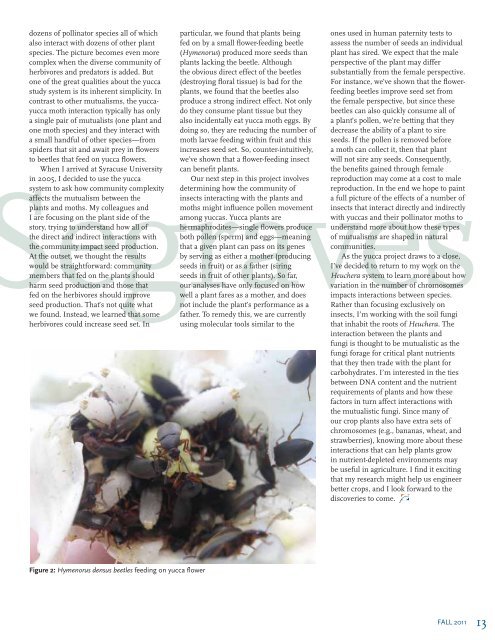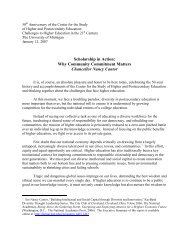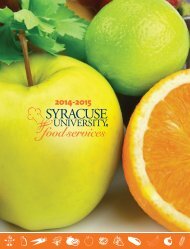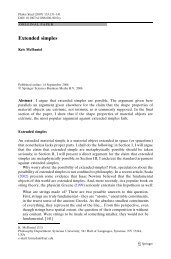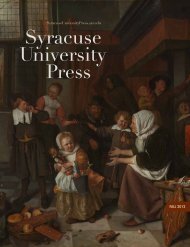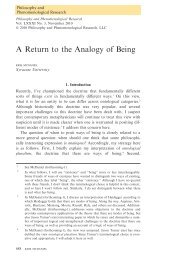Fall 2011 - the Department of Biology - Syracuse University
Fall 2011 - the Department of Biology - Syracuse University
Fall 2011 - the Department of Biology - Syracuse University
- No tags were found...
Create successful ePaper yourself
Turn your PDF publications into a flip-book with our unique Google optimized e-Paper software.
dozens <strong>of</strong> pollinator species all <strong>of</strong> whichalso interact with dozens <strong>of</strong> o<strong>the</strong>r plantspecies. The picture becomes even morecomplex when <strong>the</strong> diverse community <strong>of</strong>herbivores and predators is added. Butone <strong>of</strong> <strong>the</strong> great qualities about <strong>the</strong> yuccastudy system is its inherent simplicity. Incontrast to o<strong>the</strong>r mutualisms, <strong>the</strong> yuccayuccamoth interaction typically has onlya single pair <strong>of</strong> mutualists (one plant andone moth species) and <strong>the</strong>y interact witha small handful <strong>of</strong> o<strong>the</strong>r species—fromspiders that sit and await prey in flowersto beetles that feed on yucca flowers.When I arrived at <strong>Syracuse</strong> <strong>University</strong>in 2005, I decided to use <strong>the</strong> yuccasystem to ask how community complexityaffects <strong>the</strong> mutualism between <strong>the</strong>plants and moths. My colleagues andI are focusing on <strong>the</strong> plant side <strong>of</strong> <strong>the</strong>story, trying to understand how all <strong>of</strong><strong>the</strong> direct and indirect interactions with<strong>the</strong> community impact seed production.At <strong>the</strong> outset, we thought <strong>the</strong> resultswould be straightforward: communitymembers that fed on <strong>the</strong> plants shouldharm seed production and those thategravesfed on <strong>the</strong> herbivores should improveseed production. That’s not quite whatwe found. Instead, we learned that someherbivores could increase seed set. Inparticular, we found that plants beingfed on by a small flower-feeding beetle(Hymenorus) produced more seeds thanplants lacking <strong>the</strong> beetle. Although<strong>the</strong> obvious direct effect <strong>of</strong> <strong>the</strong> beetles(destroying floral tissue) is bad for <strong>the</strong>plants, we found that <strong>the</strong> beetles alsoproduce a strong indirect effect. Not onlydo <strong>the</strong>y consume plant tissue but <strong>the</strong>yalso incidentally eat yucca moth eggs. Bydoing so, <strong>the</strong>y are reducing <strong>the</strong> number <strong>of</strong>moth larvae feeding within fruit and thisincreases seed set. So, counter-intuitively,we’ve shown that a flower-feeding insectcan benefit plants.Our next step in this project involvesdetermining how <strong>the</strong> community <strong>of</strong>insects interacting with <strong>the</strong> plants andmoths might influence pollen movementamong yuccas. Yucca plants arehermaphrodites—single flowers produceboth pollen (sperm) and eggs—meaningthat a given plant can pass on its genesby serving as ei<strong>the</strong>r a mo<strong>the</strong>r (producingseeds in fruit) or as a fa<strong>the</strong>r (siringseeds in fruit <strong>of</strong> o<strong>the</strong>r plants). So far,our analyses have only focused on howwell a plant fares as a mo<strong>the</strong>r, and doesnot include <strong>the</strong> plant’s performance as afa<strong>the</strong>r. To remedy this, we are currentlyusing molecular tools similar to <strong>the</strong>ones used in human paternity tests toassess <strong>the</strong> number <strong>of</strong> seeds an individualplant has sired. We expect that <strong>the</strong> maleperspective <strong>of</strong> <strong>the</strong> plant may differsubstantially from <strong>the</strong> female perspective.For instance, we’ve shown that <strong>the</strong> flowerfeedingbeetles improve seed set from<strong>the</strong> female perspective, but since <strong>the</strong>sebeetles can also quickly consume all <strong>of</strong>a plant’s pollen, we’re betting that <strong>the</strong>ydecrease <strong>the</strong> ability <strong>of</strong> a plant to sireseeds. If <strong>the</strong> pollen is removed beforea moth can collect it, <strong>the</strong>n that plantwill not sire any seeds. Consequently,<strong>the</strong> benefits gained through femalereproduction may come at a cost to malereproduction. In <strong>the</strong> end we hope to painta full picture <strong>of</strong> <strong>the</strong> effects <strong>of</strong> a number <strong>of</strong>insects that interact directly and indirectlywith yuccas and <strong>the</strong>ir pollinator moths tounderstand more about how <strong>the</strong>se types<strong>of</strong> mutualisms are shaped in naturalcommunities.As <strong>the</strong> yucca project draws to a close,I’ve decided to return to my work on <strong>the</strong>Heuchera system to learn more about howvariation in <strong>the</strong> number <strong>of</strong> chromosomesimpacts interactions between species.Ra<strong>the</strong>r than focusing exclusively oninsects, I’m working with <strong>the</strong> soil fungithat inhabit <strong>the</strong> roots <strong>of</strong> Heuchera. Theinteraction between <strong>the</strong> plants andfungi is thought to be mutualistic as <strong>the</strong>fungi forage for critical plant nutrientsthat <strong>the</strong>y <strong>the</strong>n trade with <strong>the</strong> plant forcarbohydrates. I’m interested in <strong>the</strong> tiesbetween DNA content and <strong>the</strong> nutrientrequirements <strong>of</strong> plants and how <strong>the</strong>sefactors in turn affect interactions with<strong>the</strong> mutualistic fungi. Since many <strong>of</strong>our crop plants also have extra sets <strong>of</strong>chromosomes (e.g., bananas, wheat, andstrawberries), knowing more about <strong>the</strong>seinteractions that can help plants growin nutrient-depleted environments maybe useful in agriculture. I find it excitingthat my research might help us engineerbetter crops, and I look forward to <strong>the</strong>discoveries to come.Figure 2: Hymenorus densus beetles feeding on yucca flowerFALL <strong>2011</strong>13


